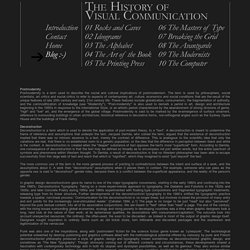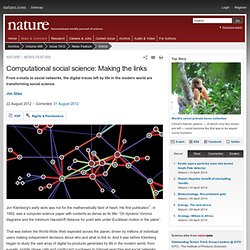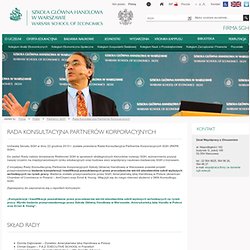

The History of Visual Communication - The Computer. Postmodernity Postmodernity is a term used to describe the social and cultural implications of postmodernism.

The term is used by philosophers, social scientists, art critics and social critics to refer to aspects of contemporary art, culture, economics and social conditions that are the result of the unique features of late 20th century and early 21st century life. These features include globalization, consumerism, the fragmentation of authority, and the commoditization of knowledge (see "Modernity"). "Post-modernity" is also used to demark a period in art, design and architecture beginning in the 1950's in response to the International Style, or an artistic period characterized by the abandonment of strong divisions of genre, "high" and "low" art, and the emergence of the global village. Deconstruction Deconstruction is a term which is used to denote the application of post-modern theory, to a "text". Further reading Neville Brody for FUSE David Carson, advertising design 1990's. Computational social science: Making the links.
Jon Kleinberg's early work was not for the mathematically faint of heart.

His first publication1, in 1992, was a computer-science paper with contents as dense as its title: 'On dynamic Voronoi diagrams and the minimum Hausdorff distance for point sets under Euclidean motion in the plane'. That was before the World-Wide Web exploded across the planet, driven by millions of individual users making independent decisions about who and what to link to. And it was before Kleinberg began to study the vast array of digital by-products generated by life in the modern world, from e-mails, mobile phone calls and credit-card purchases to Internet searches and social networks.
Today, as a computer scientist at Cornell University in Ithaca, New York, Kleinberg uses these data to write papers such as 'How bad is forming your own opinion? '2 and 'You had me at hello: how phrasing affects memorability'3 — titles that would be at home in a social-science journal. Kleinberg is not alone. Volume 1 number 3. RKPK_raport_2012.pdf (Obiekt application/pdf) Uchwałą Senatu SGH w dniu 22 grudnia 2010 r. została powołana Rada Konsultacyjna Partnerów Korporacyjnych SGH (RKPK SGH).

Do zadań Rady należy doradzanie Rektorowi SGH w sprawach strategicznych kierunków rozwoju SGH, wzmacniania pozycji naszej Uczelni na międzynarodowym rynku edukacyjnym oraz budowa sieci współpracy naukowo-badawczej SGH z biznesem. Z inicjatywy Rady Konsultacyjnej Partnerów Korporacyjnych Szkoły Głównej Handlowej w Warszawie powstał projekt przeprowadzenia badania kompetencji i kwalifikacji poszukiwanych przez pracodawców wśród absolwentów szkół wyższych wchodzących na rynek pracy. Badanie zostało przeprowadzone przez SGH, Amerykańską Izbę Handlową w Polsce (American Chamber of Commerce in Poland – AmCham) oraz Ernst & Young. Włączyli się do niego również studenci z SKN Konsultingu SGH. Zapraszamy do zapoznania się z raportem końcowym: „Kompetencje i kwalifikacje poszukiwane przez pracodawców wśród absolwentów szkół wyższych wchodzących na rynek pracy. Blogi-i-serwisy-naukowe.pdf (Obiekt application/pdf) Journal of Digital Humanities. ESA_EF_2011.pdf (Obiekt application/pdf)
FAQ - Culturomics. It turns out that if you do something that appears on the front page of the New York Times, people will ask you a lot of questions about it.

Instead of answering one-by-one, we decided to collect many of the commonly asked questions about our recent paper in Science in one place. Most of these issues are addressed in great detail in either the paper or in the Supplemental Online Materials, but those can be a somewhat daunting and technical read, so we made this to provide people with a convenient reference. 1. Is this supposed to replace close reading of texts? Absolutely not. Quite the opposite is true: quantitative methods can be a great source of ideas that can then be explored further by studying primary texts. 2. Our hope is that the culturomic approach will be able to supplement existing techniques. 3. That’s doesn’t mean you can’t use quantitative methods to get insight into culture. 4.
Great! 5. 6. If you’re writing an academic publication, please cite: II. 1. 2. That's incorrect. Peer Review the Journal. Raport-Cyfrowa-Przysz%C5%82o%C5%9B%C4%87-